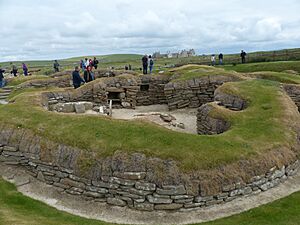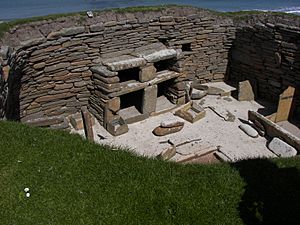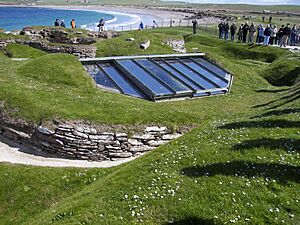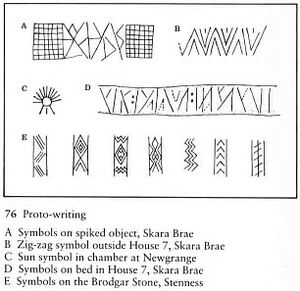Skara Brae facts for kids

Skara Brae from the entrance gate
|
|
| Location | Scotland, United Kingdom |
|---|---|
| Coordinates | 59°02′55″N 3°20′30″W / 59.0487138°N 3.3417499°W |
| Type | Settlement |
| History | |
| Founded | c. 3180 BC |
| Abandoned | c. 2500 BC |
| Periods | Neolithic |
| Site notes | |
| Discovered | 1850 |
| Ownership | Historic Environment Scotland |
| Public access | Yes |
| Type | Cultural |
| Criteria | i, ii, iii, iv |
| Designated | 1999 (23rd session) |
| Part of | Heart of Neolithic Orkney |
| Reference no. | 514 |
| Region | Europe |
| Identifiers | |
| Historic Environment Scotland | SM90276 |
Skara Brae is an amazing stone village from the Neolithic Age. This means it was built a very long time ago, when people first started farming. You can find it on the Bay of Skaill in Orkney, Scotland.
The village has ten houses made of flat stones. These houses were built into earthen mounds, which helped support their walls. Inside, each house had stone hearths for fires, beds, and even cupboards. They also had a simple sewer system with "toilets" that flushed waste into the ocean.
People lived in Skara Brae from about 3180 BC to 2500 BC. It is the most complete Stone Age village in Europe. Skara Brae is so important that UNESCO made it a World Heritage Site. It is part of "The Heart of Neolithic Orkney" group of ancient places. This village is even older than Stonehenge and the Great Pyramids of Giza! Because it is so well-preserved, some people call it the "Scottish Pompeii".
Historic Environment Scotland looks after Skara Brae. They work with other groups to protect this special place. Visitors are welcome to explore the site for most of the year.
Contents
How Skara Brae Was Found
A Storm Reveals an Ancient Village
In the winter of 1850, a huge storm hit Scotland. It caused a lot of damage. At the Bay of Skaill, the storm washed away earth from a large hill. After the storm, local people saw the outlines of a village with several small houses. These houses had no roofs.
William Graham Watt, a local landowner's son, started digging at the site. He was a self-taught geologist. After four houses were uncovered, the digging stopped in 1868.
Later Discoveries and Digging
The site stayed quiet until 1913. Then, some people with shovels took unknown items from the village. In 1924, another storm damaged one of the houses. This made people realize the site needed proper care.
Professor V. Gordon Childe from the University of Edinburgh took over the work. He first visited Skara Brae in 1927. He made sure the village was protected and studied correctly.
Women in Archaeology
In 2019, old photos of Professor Childe and four women at the dig were looked at again. People used to think the women were just visitors. But a note on the back of the photos said they were "4 of [Childe's] lady students." This means they were actively helping with the digging! These women were likely Margaret E. B. Simpson, Margaret Mitchell, Mary Kennedy, and Margaret Cole.
Life in the Stone Age Village
Homes Built for Comfort
The people of Skara Brae made a special kind of pottery called grooved ware. Their houses were built into mounds of old household waste, called middens. This "earth sheltering" made the houses strong. It also kept them warm during Orkney's cold winters.
Each house was about 40 square meters (430 square feet). They had a big square room with a stone hearth in the middle. This hearth was used for heating and cooking. It seems that about fifty people lived in Skara Brae at any one time.
What They Burned for Heat
It's not clear what the villagers used for fuel in their hearths. Some thought it was peat, but studies show peat wasn't common then. They might have burned driftwood or animal dung. There is also evidence that dried seaweed was used. Sometimes, a glassy material called "kelp" or "cramp" is found, which could be burnt seaweed.
Stone Furniture and Toilets
The houses had many stone-built furniture pieces. These included cupboards, dressers, seats, and storage boxes. Each home had a low doorway with a stone slab door. A bone bar could slide into holes to close the door.
Some houses had a small extra room. This room led to a stone drain that went out of the village. People think these small rooms were indoor toilets.
House Layout and Family Life
Seven of the houses had similar furniture layouts. The beds and dressers were always in the same spots. The dresser was opposite the door, so it was the first thing you saw. Each of these houses had a larger bed on the right and a smaller one on the left.
Some experts think the larger bed was for the husband and the smaller for the wife. Beads and paint pots found in smaller beds might support this idea. Stone boxes near most doorways made people turn right, towards the "male" side of the house. Stone pillars near the beds might have held fur canopies, like those used in the Hebridean islands long ago.
House 8: A Workshop?
House 8 was different. It had no storage boxes or dresser. Instead, it was divided into small areas. Bits of stone, bone, and antler found there suggest it was used to make tools. Things like bone needles or flint axes might have been made here.
Signs of heat-damaged rocks and a possible flue also point to it being a workshop. House 8 was also special because it stood alone. It was not surrounded by midden, and its walls were over 2 meters (6.5 feet) thick. It even had a "porch" at its entrance.
Ancient Fleas and Food
Scientists found the oldest known record of the human flea (''Pulex irritans'') in Europe at Skara Brae.
The people of Skara Brae were mostly farmers who raised cattle, pigs, and sheep. At first, it was thought they did not grow crops. But later digs found barley seeds, showing they did farm. Fish bones and shells in the waste piles mean they also ate a lot of seafood. Limpet shells were common and might have been used as fish bait. They kept this bait in waterproof stone boxes in their homes.
Connecting to Other Sites
A special "low road" from Skara Brae passes near other ancient sites. These include the Ring of Brodgar and the Standing Stones of Stenness. This road ends at the tomb of Maeshowe. Such low roads connected important Stone Age places all over Britain.
When Skara Brae Was Left Behind
Dating the Village
At first, experts thought the village was from around 500 BC. But new digs in 1972–73 helped solve the mystery. Using radiocarbon dating, they found that people started living in Skara Brae around 3180 BC. They stayed there for about six hundred years.
Why Did People Leave?
Around 2500 BC, the weather changed. It became much colder and wetter. The people of Skara Brae might have left because of this climate change. There are many ideas about why they left.
One popular idea is that a huge storm made them leave quickly. Some thought they left so fast that they left behind valuable items like necklaces and pins. They even left food in their beds.
However, other experts disagree. They believe the village was not abandoned suddenly in a storm. Instead, they think the burial of the village by sand happened slowly. The people had already left for reasons we don't fully know.
The site was once further from the sea than it is today. It might have been next to a fresh water lagoon, protected by sand dunes. Some parts of the village were lost to sea erosion before it was rediscovered. More ancient structures are known to exist nearby, hidden under fields.
Amazing Ancient Objects
Carved Stone Balls and Symbols
Some mysterious carved stone balls were found at Skara Brae. You can see some of them in the museum. Similar objects have been found across northern Scotland. The spiral designs on some of these balls look like designs found in Ireland's Boyne Valley.
Similar symbols are carved into stone doorways and bed posts. These symbols have been called "runic writings." Some people have tried to translate them. For example, one author thought that "colons" between symbols might separate words.
Tools and Art from Nature
Lumps of red ochre were found here. This suggests that people might have used it for body painting. Smooth pieces of haematite were also found. Their shiny surfaces suggest they were used to polish leather.
Many other tools were made from animal, fish, and bird bones. They also used whale and walrus ivory, and orca teeth. These tools included awls (for making holes), needles, knives, beads, adzes (like axes), shovels, and small bowls. There were even ivory pins up to 25 centimeters (10 inches) long. These pins are like ones found in Irish tombs, showing a possible link between the cultures.
The Skaill knife was a common tool at Skara Brae. It was a large, sharp stone flake used for cutting. This tool is named after the Bay of Skaill where Skara Brae is located. Skaill knives have been found all over Orkney and Shetland.
Rare Preserved Items
The 1972 digs found parts of the site that were waterlogged. This helped preserve items that would usually rot away. These included a twisted piece of heather, which is one of the few known examples of Stone Age rope. A wooden handle was also found.
In 2016, a carved whalebone figure was rediscovered in a museum box. It's called 'Skara Brae Buddo' and is thought to be 5,000 years old. It has four holes that look like eyes, a mouth, and a belly button. This figure was only known from a drawing made in the 1800s.
Other Ancient Sites in Orkney
Knap of Howar
Knap of Howar, on the island of Papa Westray, is another well-preserved Stone Age farm. It dates from 3500 BC to 3100 BC. It looks similar to Skara Brae but is even older. It is thought to be the oldest standing building in northern Europe.
Barnhouse Settlement
The Barnhouse Settlement is near the Loch of Harray on the Orkney Mainland. It's close to the Standing Stones of Stenness. Digs there from 1986 to 1991 found at least 15 house foundations. These houses are like the early ones at Skara Brae. They have central hearths, beds against walls, stone dressers, and drains. But these houses seem to have stood alone, not built into mounds. This settlement is from about 3000 BC.
Rinyo and Links of Noltland
A similar, but smaller, site is at Rinyo on Rousay. Also, a site called Links of Noltland on Westray is being dug up. It also seems to have things in common with Skara Brae.
Skara Brae: A World Heritage Site
"The Heart of Neolithic Orkney" became a World Heritage site in December 1999. This group includes Skara Brae, Maeshowe, the Ring of Brodgar, the Standing Stones of Stenness, and other nearby places.
Historic Environment Scotland manages these sites. They say that the monuments show how amazing people were in early times, even in faraway places. These sites are from around the same time as the first pyramids in Egypt and early cities in India. They are very special for their age and show a lot about ancient people's achievements.
Future Risks from Climate Change
In 2019, experts looked at how climate change might affect Skara Brae. A report by Historic Environment Scotland and others found that the entire Heart of Neolithic Orkney World Heritage Site is "extremely vulnerable." This is because of rising sea levels, more rain, and other climate changes. The report also warned that one very bad storm could partly destroy Skara Brae.
See also
 In Spanish: Skara Brae para niños
In Spanish: Skara Brae para niños
- Maeshowe
- Ness of Brodgar
- Skaill House
- Standing Stones of Stenness
- Zenith of Iron Age Shetland
- Timeline of prehistoric Scotland
- List of oldest buildings
- List of oldest buildings in the United Kingdom
- List of World Heritage Sites in Scotland






